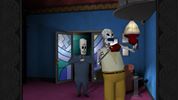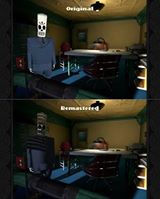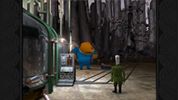Liverpool Sound and Vision Rating: 9.5 out of 10
Grim Fandango: Remastered is a story driven third-person adventure puzzle game available for download from the PlayStation Store for the PS4 and PS Vita. The game is an enhanced version of the cult classic point and click adventure which was originally released in October 1998 and is known as one of LucasArts’ best games amongst many big name classics such as Star Wars and Indiana Jones. Grim Fandango was met with mass critical acclaim upon release with many awards in 1998 such as Adventure Game of the Year from PC Gamer, IGN, Game Critics Awards and Academy of Interactive Arts & Sciences as well as an entire range of GameSpot awards with a lot of recognition for the quality the game possessed. Tim Schafer who is known for his work on other such classic games as Day of the Tentacle and Psychonauts was the project lead on the original release of Grim Fandango which he stated cost around $3 million to develop and he also lead the project of remastering the game with Double Fine Productions.
The story revolves around the lead character Manuel ‘Manny’ Calavera who has fallen on hard times having been forcibly assigned as a travel agent at the Department of Death in the city of El Marrow due to owing a debt to the powers that be which he must work off, although becoming increasingly frustrated by consistently being assigned with clients that have to take the four year journey and to make things even worse; his job is actually threatened by his boss Don Copal if he does not find better clients in order to work the debt of which he has no idea why he even owes it in the first place.
The environment design has elements of film noir, while being based upon the Art Deco found in San Francisco which inspired the fusion of Mayan and Mexican Art Deco architectural styles throughout the game with the building the business is located within even actually being based upon the real life San Francisco building 450 Sutter in Union Square which preserves 26 stories of Art Deco elegance having been designed by the world famous architect Timothy Pflueger and is such an important building to be listed on the National Register of Historic Places.
The character design is based upon the Mexican Calaca figures which have origins dating back to Aztec times consisting of a skull and a skeleton which are used as decorations to celebrate the Mexican Day of the Dead festival and is therefore rather fitting in regards to the subject matter of the story, while the Calaca figures have also been used in two of Tim Burton’s films The Nightmare Before Christmas and Corpse Bride as well as Neil Gaiman’s film Coraline.
There is a special features section comprising of a render mode, aspect ratio, director’s commentary, cut scenes, concept art gallery and dialogue transcripts. The render mode allows players access to the game with the original graphics untouched or with remastered graphics including smoother character models and improved lighting and shadows, while the aspect ratios consist of the original 4:3 ratio with black borders from the television and monitor displays of the 1990s as well as the original 4:3 ratio with stylised borders and a new 16:9 widescreen ratio which stretches the 4:3 ratio outwards rather than displaying more of the surrounding environment. There are also the abilities to watch cutscene videos to recap the story, view concept art throughout an entire gallery of 98 pictures and an entire dialogue transcript which can be scrolled through to read the conversations and comments from each character that are collectively unlocked as you progress through the game.
The director’s commentary includes analysis from the project leader and writer Tim Schafer as well as many of the team who worked on the original game regarding multiple facets of pretty much every scene including such interesting facts as the audio director having to fight for 5% of the CPU’s performance in order to provide real-time reverb rather than pre-baked audio for the garage scene, amongst many more facts which will resonate with the cult fan base Grim Fandango has built over the years since its original release.
Grim Fandango: Remastered supports cross-buy and cross-save between the PS4 and Vita. Cross-buy presents a superb amount of value as it means that players will be purchasing the PS4 and Vita versions of the game with just a single purchase. The cross-save functionality allows players to sync the progression of the save file from the Vita to the PS4 and vice versa, so the game can be started on the Vita on the way to and from work, sync the saved game when returned home and then resume where it was left off and continuing via the PS4 version. The cross-save feature is made possible by uploading the save file to the cloud on one console and downloading it from the other console. However, in this case there is no auto save feature despite being a staple feature of most modern games, but is something that the remaster has not addressed, so it is advised to save progression regularly.
The controls are well mapped to the DualShock 4 controller with the control scheme consisting of pressing X to use an item, talk or skip dialogue; pressing square to examine item; pressing triangle to open inventory; pressing O to pick up an item, put an item away or skip a cutscene; pressing R1 to run while moving; pressing L1 to listen to the director’s commentary; pressing R3 to toggle render mode between remastered and original; changing the direction of the left analogue stick or alternatively pressing up, down, left or right on the d-pad to move your character; pressing the share button takes you to the share feature menu; and pressing the options button to display the pause menu. There are two movement modes camera relative and tank controls with the camera relative mode being far more fluent in how the control input relates to the actions portrayed on screen, while the tank controls are rather hard to get used to and show the progression of controller input since the game was released in 1998.
There is no touch pad implementation which is surprising as the Vita version has a faithful point and click style control scheme focused around the touch screen, therefore the DualShock 4 controller’s touch pad could have realistically acted as an alternative to the left analogue stick and d-pad for moving by swiping in the appropriate direction required to move in or tapping the touch pad to interact with an object or select a dialogue choice, while there is no light bar implementation although the applications would be somewhat limited to the colour changing to match the selection of dialogue or to glow orange when Manuel is smoking, alongside no DualShock 4 vibration which is surprising as it could have vibrated to reflect anything loud within the surrounding environment.
The graphics possess improved lighting and shadows as there are remastered and original graphical renderings that can be switched back and forth at any given moment which tends to particularly improve how the characters look by providing significant smoothing around the edges and far more realistic lighting and shadows cast upon all of the character models, although the environments have not been improved, but still look great which if anything is a testament to how good the game looked when it was originally released in 1998.
The presentation of the game is solid with a great user interface across various menus such as the main menu, special features menu, cutscenes menu, concept art gallery menu, dialogue transcripts, options menu and gameplay menus with support for navigation via the left analogue stick, directional pad and face buttons, although it does not include support for navigation via the right analogue stick and touch pad. The background of the menu screens revolves around some of the main characters standing in front of a tall building which is presented stylistically in a black and white tone.
The voice-over cast is quite large as all of the characters have their own voice-overs. The cast includes Tony Plana who voices Manuel Calavera who is known for his roles as Omar in 24, Roberto Santiago in Resurrection Boulevard and Ignacio Suarez in Ugly Betty. Maria Canals Barrera voices Mercedes ‘Meche’ Colomar and has previously voiced She-Hulk on Marvel vs. Capcom 3, Ellen Yindel in Batman: The Dark Knight Returns Parts 1 and 2 as well as appearing in a number of television series, while Alan Blumenfeld voices Glottis who has had starring roles as Maury Parkman in Heroes and Martin Baum in Righteous Kill as well as voicing various roles such as Willard in Jak and Daxter: The Precursor Legacy and Boyd Cooper in Tim Schafer’s Psychonauts, while there is a vast range of talent throughout the rest of the voice-over cast too.
The sound effects consist of characters such as Manuel smoking, walking, running, typewriting, computers, cars and much more besides. The original soundtrack sourced from the midi files has been re-recorded for a higher level of audio quality as the composer Peter McConnell did not believe the original Pro Tools samples stood the test of time, therefore the decision was made to re-orchestrate the score from the ground up with The Melbourne Symphony. There is no DualShock 4 speaker implementation which is surprising as it could have produced voice-overs, sound effects or music to provide a further layer of audio.
The trophy list includes 48 trophies with 38 bronze, 7 silver, 2 gold and 1 platinum trophy. The vast majority of the trophy list revolves around exploring the possible outcomes of the conversations Manuel has with other characters he encounters along his journey throughout the game such as the “What I Did Back in the Fat Days Is None of Your Business. You Know the Rules” bronze trophy for talking to Eva about how she got stuck here by using all of the conversation options with Eva. However, there are some harder trophies such as The Right Way gold trophy for completing the entire game with tank controls which contains a humorous side note explaining that Tim Schafer demanded this trophy, while the Year 4 gold trophy is awarded for spending 4 years in the Eighth Underworld by completing the entire game as progression is made through all of the puzzles. It is estimated that depending upon skill and a good trophy guide to provide some helpful tips that it would take around 10 to 20 hours to platinum the trophy list.
There are no difficulty levels, but there is an appropriate difficulty curve as there are plenty of puzzles to solve, resulting in the difficulty curve being the equivalent to how hard you find the puzzles to overcome. There will be a few puzzles that may have the player scratching their head in regards to what should be done next, but with some logic and process of elimination; players will figure out the majority of the puzzles sooner, rather than later.
There are no local or online multiplayer features which are understandable given the focus on the story and character driven narrative, although perhaps a local or online form of co-operative multiplayer for two players would have provided a significant focal point of a new experience within the existing one by allowing the two players to experience the story together. There is no online leaderboards which could have featured time based leaderboards for how quickly each player would take to solve a puzzle, complete a year of the game and completing the entire game. However, while multiplayer features and online leaderboards would have added further life to the remaster; the exclusion of local or online multiplayer and online leaderboards do not detract from the experience.
The replayability stems from the excellent story and adventure encountered throughout the game, while the remastered graphics appropriately polishes up the character models, lighting and shadows, although the fans of the original who have already enjoyed the game on P.C. many years ago will most certainly enjoy the range of special features most of all as they provide a fresh insight due to the thorough expert analysis of the development cycle of the original game.
Overall, attention has been placed in the appropriate areas of the remaster from the improved graphics to the plethora of special features. If you missed Grim Fandango on the P.C. in 1998 and ever since, then the remaster is a must purchase in order to experience a timeless classic story driven adventure game and if you have already played it, then it is time to experience a worthy remaster of it on PS4 or portably via PS Vita.
Jason Bonnar
Analysis
- Title: Grim Fandango: Remastered
- Developer: Double Fine Productions
- Publisher: Double Fine Productions
- System: PS4 and PS Vita
- Format: PSN Download
- Cross-Buy: Yes (PS4 and PS Vita)
- Cross-Play: Yes (Cross-Save)
- Players: 1
- Hard Drive Space Required: 4.51GB (Version 1.01)


